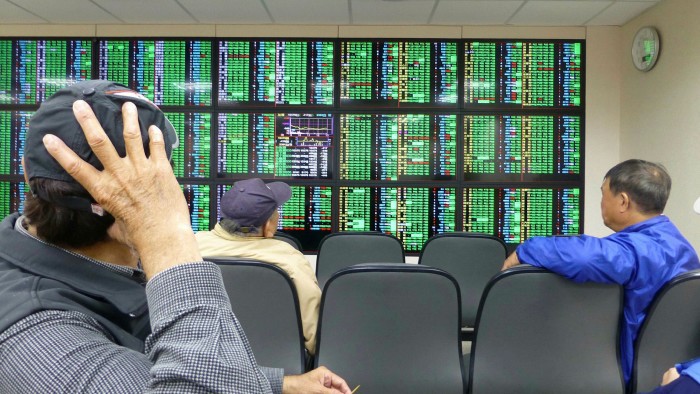Taiwan’s global bond ETF market suffers sharp reversal in 2020

Simply sign up to the Exchange traded funds myFT Digest -- delivered directly to your inbox.
More on ETFs
Visit the FT’s ETF Hub for news and analysis, investor education and tools to help you select the right ETFs.
Taiwan’s bond exchange traded fund market ended years of strong growth last year amid disappointing performance and the appreciation of the local currency.
Total assets in Taiwan’s locally domiciled foreign bond ETF market fell by NT$81bn ($2.9bn) to NT$1.26tn during 2020, according to data from the Securities Investment Trust & Consulting Association.
The outflows came even as assets in domestic stock ETFs more than doubled, jumping from NT$127.45bn at the end of 2019 to NT$261.62bn at the end of last year, Sitca data show.
The raft of global bond ETF launches over the past few years propelled Taiwan’s bond ETF market to become the largest in Asia in 2018 and helped the ETF market’s 135 per cent growth in assets over the past two years.

This article was previously published by Ignites Asia, a title owned by the FT Group.
“The fast growth of the Taiwan bond ETF market in 2018 and 2019 was mostly driven by insurers who benefited from tax and regulatory incentives by investing in bond ETFs,” said Donna Chen, Taipei-based founder and president of Keystone Intelligence.
But investors have been put off the bond ETF market due to its poor performance.
Only 18 out of the nearly 100 locally domiciled bond ETFs in Taiwan notched up positive returns last year.
“In 2020, the average performance of the bond ETFs was only 4.3 per cent. In contrast, the domestic and global stock markets performed very well. So much capital relocated into the stock market last year,” Chen said.
Taiwan’s insurers had been piling into foreign bond ETFs to circumvent a 65 per cent cap on their offshore investment and the cap on their holdings of locally issued foreign corporate bonds.
Holdings in foreign bond ETFs, for now, do not count towards their overseas investments. At one point in August 2019, domestic insurers accounted for 96 per cent of Taiwan’s bond ETF assets.
But Taiwanese regulators have been trying to put brakes on the market’s massive growth due to liquidity concerns.
The Financial Supervisory Commission imposed caps on investors’ holdings in May 2019. Under the new rules, ETF providers must limit the amount a single investor can own to 50 per cent when launching new bond ETFs, down from the commonly seen 80-90 per cent. The stake should be further reduced to 30 per cent after six months.
To make matters worse, Sitca issued an industry circular to fund managers last September forbidding them from conducting asset raising for two bond ETFs in a row.
The 30 per cent single-investor ownership cap was relaxed in November last year to 50 per cent, Ignites Asia reported at the time. The bar will be further raised to 70 per cent for products that are smaller in size.
The top 10 performing bond ETFs all target US bonds, with nine out of the 10 focusing only on US Treasuries. The only strategy that does not invest purely in US Treasuries is the KGI 15 Plus Year US Healthcare and Pharma Bond ETF.
Among the 18 bond ETFs that recorded positive returns, the vast majority track long-term US Treasuries or Chinese policy bank bonds, according to the local media.
Chen pointed out that the local currency appreciated by 5.3 per cent against the US dollar in 2020, which would have had a negative impact on offshore investments because of the cost of the increased costs of converting any gains back into Taiwan dollars.
Despite extremely low retail investor interest in Taiwan’s bond ETFs so far, that could change, some industry figures said.
“Bond ETFs are quite stable in price, but Taiwanese retail investors like volatility. So they tend to go for stock ETFs or, even better, leveraged ETFs,” Ye Songhuan, a portfolio manager at CTBC Investments, said.
But the market’s stability may be its strength in 2021. There may be higher volatility this year than the year before in the stock market, Commercial Times reported, citing analysis from domestic institutional investors. In such an environment, bond ETFs may offer a haven given their low volatility.
There is also a growing trend towards purchasing several bond ETFs to create a portfolio that will deliver dividend payments to retail investors, an executive from Yuanta Securities Investment Trust said.
Recent regulatory developments are likely to entice more retail investors to the market as well.
Previously, it was expensive to invest in bond ETFs. One trading unit for bond ETFs typically costs about NT$40,000. However, since late October last year, the Financial Supervisory Commission has allowed intraday odd-lot trading, hoping to make high-value stocks and investment products more affordable for individual investors. For the first time, Taiwanese investors can trade odd lots during the day as opposed to only after the market close.
So far this year, seven bond ETFs have been launched in Taiwan, according to Sitca. Among them, three have an ESG theme, one targets high-yield bonds in emerging markets, and the remaining three invest in global investment grade bonds or a combination of high-yield and investment grade bonds.
*Ignites Asia is a news service published by FT Specialist for professionals working in the asset management industry. It covers everything from new product launches to regulations and industry trends. Trials and subscriptions are available at ignitesasia.com.

Click here to visit the ETF Hub

Comments